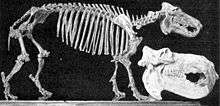Hippopotamus madagascariensis
Hippopotamus madagascariensis or Choeropsis/Hexaprotodon madagascariensis is a recently extinct species of Malagasy hippopotamus.
| Hippopotamus madagascariensis Temporal range: Late Holocene | |
|---|---|
 | |
| Skeleton of H. madagascariensis next to a skull of the modern hippo | |
| Scientific classification | |
| Kingdom: | Animalia |
| Phylum: | Chordata |
| Class: | Mammalia |
| Order: | Artiodactyla |
| Family: | Hippopotamidae |
| Genus: | Hippopotamus |
| Species: | †H. madagascariensis |
| Binomial name | |
| †Hippopotamus madagascariensis Solweig Stuenes, 1989 | |
Taxonomy
Malagasy hippopotamuses were first discovered in the mid-19th century by Alfred Grandidier, who unearthed nearly 50 individual hippos from a dried-up swamp at Ambolisaka near Lake Ihotry,[1][2] a few miles from the Mozambique Channel. In 1989, Scandinavian palaeontologist Solweig Stuenes described H. madagascariensis and H. lemerlei from these bones.[3][4]
It has been classified as a species of pygmy hippopotamus (genus Choeropsis or Hexaprotodon), though similarities may simply be due to convergent evolution. Other Malagasy hippos are classified into the genus Hippopotamus.[5]
Description
Like the modern pygmy hippopotamus, the Malagasy pygmy hippo had eyes on the side of its head rather than high orbits and teeth of the common hippopotamus. The Malagasy pygmy hippo was similarly less aquatic, with many of its fossils found in the forested highlands of Madagascar.[4]
Fossils of both the Malagasy pygmy hippopotamus and H. lemerlei show a cursorial adaptation, distinct from the hippos on the African continent, and they would have been much better runners.[5]
Extinction
Although there have been no remains dating to within the last thousand years, the hippopotamus has been surprisingly common in Malagasy oral legends. In different regions of Madagascar, stories were recorded of the mangarsahoc, the tsy-aomby-aomby, the omby-rano, and the laloumena, all animals that resembled hippopotamuses.[6] The strength of these oral traditions led the International Union for Conservation of Nature (IUCN) to classify H. madagascarensis as recently extinct (going extinct some time after the year 1500).[7]
At least seven hippopotamus bones show unequivocal signs of butchery, suggesting that they survived until humans arrived on Madagascar. Humans and hippos may have coexisted for about 2,000 years. It is possible overhunting by humans led to their extinction.[4]
References
- Stuenes, S. (1989). "Taxonomy, habits and relationships of the sub-fossil Madagascan hippopotamuses Hippopotamus lemerlei and H. madagascariensis". Journal of Vertebrate Paleontology. 9 (3): 241–268. doi:10.1080/02724634.1989.10011761.
- Nussbaum, Ronald A.; Raxworthy, Christopher J. (2000). The Ghost Geckos of Madagascar. New York: William Morrow. ISBN 978-0-380-97577-8.
- Stuenes, S. (1989). "Taxonomy, habits and relationships of the sub-fossil Madagascan hippopotamuses Hippopotamus lemerlei and H. madagascariensis". Journal of Vertebrate Paleontology. 9 (3): 241–268. doi:10.1080/02724634.1989.10011761.
- Tyson, P. (1998). The Eighth Continent; Life, Death and Discovery in the Lost World of Madagascar. Ann Arbor: Museum of Zoology, University of Michigan. ISBN 978-0380794652.
- Eltringham, S.K. (1999). The Hippos. Poyser Natural History Series. London: Academic Press. ISBN 978-0-85661-131-5.
- Burney, David A.; Ramilisonina (December 1998). "The Kilopilopitsofy, Kidoky, and Bokyboky: Accounts of Strange Animals from Belo-sur-mer, Madagascar, and the Megafaunal "Extinction Window"". American Anthropologist. 100 (4): 957–966. doi:10.1525/aa.1998.100.4.957. JSTOR 681820.
- Boisserie, J.-R. (2016). "Hippopotamus madagascariensis". IUCN Red List of Threatened Species. 2016. doi:10.2305/IUCN.UK.2016-1.RLTS.T40783A90128828.en.CS1 maint: ref=harv (link)